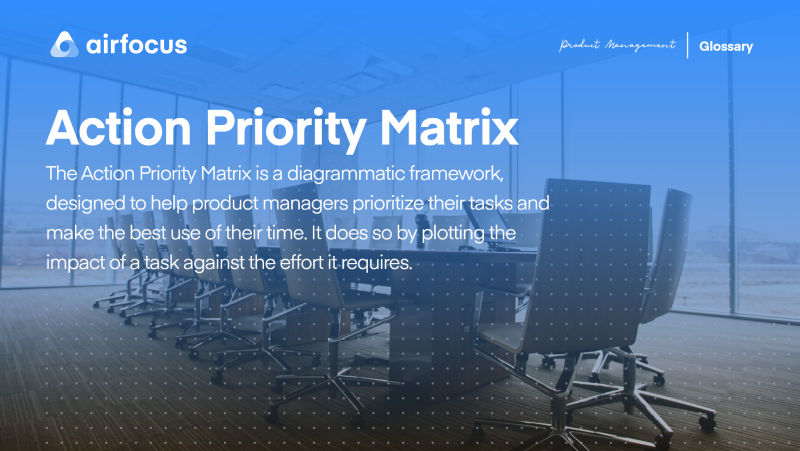Action Priority Matrix
What is the action priority matrix?
Definition of the action priority matrix
The action priority matrix is a diagrammatic framework, designed to help product managers prioritize their tasks and make the best use of their time. It does so by plotting the impact of a task against the effort it requires.
With seemingly never-ending to-do lists, deciding which task to tackle next isn’t easy. When it comes to product managers working through a complex product roadmap, that can go double.
With an action priority matrix, deciding what to work on next becomes less about guesswork and more about logic.
Rather than relying on gut instinct, the matrix allows you to balance the impact of a task against the amount of effort it requires to complete — making it much easier to find the sweet spot where real productivity happens.
What is the action priority matrix used for?
One of the biggest challenges for anyone in the modern working world boils down to a single word: prioritization.
It often feels like we all have less time to do more stuff, meaning doing things in the right order all can make all the difference.
Download Now: Get our eBook on Mastering Prioritization
The action priority matrix is used to simplify the prioritization and decision-making process, eliminating any subjective considerations and instead focusing on objective dimensions such as time sensitivity, energy requirements, related tasks, and more. Ultimately, encapsulated by two categories: impact and effort.
How to create an action priority matrix?
Visually, an action priority matrix resembles a square diagram broken into quadrants, with the y-axis on the left side labeled effort and the x-axis along the bottom labeled impact.
Effort refers to how much time, energy, hours, and other physical or mental resources will be required to complete a task. Impact refers to the positive effect completing the task will have on the business or the overall project (increased MRR, downloads or sign-ups, etc.)
Now that you’ve got the visualization down, let’s go back to those quadrants.
There are, as the name suggests, four of them which make up the square chart:
Quick wins, in the upper-left, are low-effort, high-impact.
Major projects, in the upper-right, are high-effort, high-impact.
Fill-ins, in the lower-left, are low-effort, low-impact.
Thankless tasks, in the lower-right, are high-effort, low-impact.
It should be fairly self-explanatory what each of these quadrants means. But how do you actually use the matrix?
Here’s a quick step-by-step:
List out all of your outstanding tasks.
Next, assign a numeric value of 1-10 to each task twice, rating it for effort and impact.
On your Action Priority Matrix diagram, add the numbers 1-10 to each labeled axis at even increments.
Finally, use your numeric assignments to plot each task directly onto the matrix.
Once you’ve completed these steps, you’ll be left with a practical, visual, and objective representation of what really matters.
From here, it’s much easier to prioritize your workload. Do you want to tackle quick wins with a bit of free time? Or perhaps take a deep dive into some of those major projects?
Whichever way you choose to prioritize your approach, the Action Priority Matrix will give you four buckets from which you can pluck tasks whenever you’re ready for them, rather than taking the lucky dip approach of the past.
Who created the action priority matrix?
The concept of the action priority matrix was first inspired by renowned author and business leader Stephen Covey.
In his 1989 bestselling book 7 Habits of Highly Effective People, Covey described the so-called “four quadrants”.
Very similar in structure to the action priority matrix, the key difference in Covey’s first iteration is that the two main axes are importance and urgency.
Within the quadrants, the key categories are simple combinations of importance and urgency, as opposed to the action priority matrix, which offers more well-defined, actionable categories (like quick wins).
Benefits of using the action priority matrix
It should be clear by now that the action priority matrix is a powerful tool, especially for teams working on complex projects with many moving parts. But why else should you consider giving this framework a try?
Here are just a few key benefits.
It brings clarity and meaning to an otherwise unordered list of tasks
We’ve all been there: staring at a seemingly never-ending list of tasks with no idea where to start. By implementing the action priority matrix, you or your team can almost immediately sort outstanding tasks into buckets. From there, you can decide what matters most — and what you might consider eliminating altogether.
It makes it easier to gain buy-in from key stakeholders
If you work in a product team, you’ll already know that having buy-in from the larger organization is essential to make things happen. But that’s not an easy win when all you have is an inkling that this is the right path for the team.
With the action priority matrix, you can use objective, real-world data to produce a convincing rationale as to why a certain task should be done first. It could be that the effort justifies the impact or vice versa. But the matrix gives you a tool to make it happen.
Download now: Get our 5-minute guide on How To Use the Value vs Effort Model
It’s an antidote to analysis paralysis
There’s a concept in psychology called ‘selective attention’, whereby we focus our attention on just one thing and disregard all the other noise in the surroundings. The action priority matrix is an example of this phenomenon transposed into a practical framework, meaning it can help you see the wood for the trees. Even better, it can prevent you from feeling the stress triggered by having too many choices at once, also known as analysis paralysis.

General FAQ

Glossary categories
Prioritize with confidence

Experience the new way of doing product management







